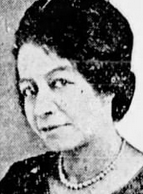Ethel Ernestine Harper facts for kids
Quick facts for kids
Ethel Harper
|
|
|---|---|

Ethel Ernestine Harper, from a 1932 newspaper.
|
|
| Born | September 17, 1903 |
| Died | March 31, 1979 (aged 75) |
| Occupation | Singer, performer, clubwoman |
| Known for | Portrayed Aunt Jemima in the 1940s and 1950s |
Ethel Ernestine Harper (September 17, 1903 – March 31, 1979) was an African-American teacher and performer. She became well-known for playing the Aunt Jemima advertising character in the 1950s.
Contents
Early Life
Ethel Ernestine Harper was born in Greensboro, Alabama. She was the youngest child and only daughter of Wiley W. Harper and Emma Louise Jones Harper. Both of her parents were teachers.
When Ethel was nine years old, her parents passed away. She then moved from Selma to Birmingham. There, she lived with her older brother and his wife. Ethel graduated from Industrial High School. She then trained to be a teacher at the State Teachers College in Montgomery. This school is now called Alabama State University.
Ethel Harper's Career
Teaching in Alabama
As a young woman, Ethel Harper taught in Northport, Alabama. She also gave private music lessons. Later, she returned to teach at her old school, Industrial High. There, she started the Girls' Minstrel, a yearly musical and theater show.
While teaching at Parker High School in Birmingham, Ethel led a music group. It was called the Ethel Harper Rhythm Boys. This group of teenage students toured around Alabama. One of the students was Sonny Blount, who later became the famous jazz composer Sun Ra. In 1932, Ethel became the president of the Birmingham City Federation of Colored Women's Clubs. Ethel taught in Alabama for twelve years. In 1936, she moved to New York to follow her dream of a music career.
Music Performances
In New York, Ethel Harper performed at the Apollo Theatre's Amateur Hour in 1936. She won the competition! Soon after, she appeared in a show called Connie's Hot Chocolates of '37. She performed with a group called the Melody Maids.
In 1939, she was in a Broadway show called The Hot Mikado. This was a swing music version of a famous musical play by Gilbert and Sullivan. She performed with the legendary dancer Bill "Bojangles" Robinson. In 1942, she was in Harlem Cavalcade. During World War II, she toured with the Four Ginger Snaps. They performed for soldiers and made recordings. In the mid-1950s, she toured the United States and Europe. She was part of the Negro Follies, a musical group with twenty-five singers and dancers.
Portraying Aunt Jemima
In 1950, Ethel Harper tried out for the role of Quaker Oats' Aunt Jemima. She got the part! Her friend Edith Wilson also played Aunt Jemima on radio and television from 1948 to 1966.
As the face of the company's pancake syrup, Ethel Harper appeared in person. She went to pancake festivals, schools, and hospitals. She continued in this role until 1958. After 1958, the face of Aunt Jemima was a mix of different features, not one real person.
Girl Scouts and Later Years
After her time as Aunt Jemima, Ethel Harper moved to Morris County, New Jersey. From 1958 to 1967, she worked for the Morris Area Girl Scout Council. She had many different jobs there. These included director, program coordinator, and staff advisor. After nine years with the New Jersey Girl Scouts, Ethel moved to the Girl Scout Council of Greater New York. She retired from Scouting in 1969.
Starting in 1962, Ethel taught black history classes in Morristown. She also worked to help the community at Wetmore Towers. This was a housing complex for older people. She helped organize a yearly event to raise money for Meals on Wheels. She hosted a radio talk show called Youth Speaks Out; Age Speaks Out; Are You Listening?. She also put on a performing arts show called Extravaganza of the Arts at Morristown High School. She was very active in the Morristown chapter of the NAACP.
Personal Life
Ethel Harper passed away in 1979 from a heart attack. She was driving in Morristown at the time and was 75 years old. Her personal papers are kept at the Morristown Library. These papers include a book she wrote about her own life in 1970.

